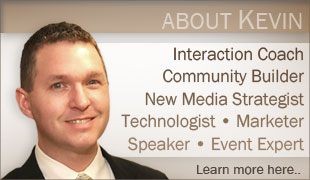-
Recent Posts
- What is the Cost of a New Customer?
- 10 Tools that Keep the Virtual Lyons Den Tame
- Anatomy of Mashable’s #MashableSummit Hashtag
- Using Social Media to Weather the Storm during Hurricane Season
- Foursquare Check-ins: The Low-Hanging Fruit
- 13 Ways to Grow Your Business on the Internet
- 5 Steps to Bring Foursquare Check-Ins to Your Door
- 5 Tips for Thriving in Social Media
- 9 Keys to Making Live Events Social Media Friendly
Categories
Interaction Coach • Social Media Strategist • Engagement Architect









Using Social Media to Weather the Storm during Hurricane Season
If you live in an area that is susceptible to hurricanes I encourage you to read NOAA’s Hurricane Basics website, educate yourself and have a plan.
Surrounding Memorial Day weekend in Florida it is customary to see the meteorologists of each major television network produce and air hurricane preparedness programs. I was honored to be contacted by Megan Hatton, Weather Producer and Meteorologist with Storm Team 8 (WFLA – Tampa’s NBC affiliate), to discuss tips for using social media during the hurricane season for their hour long special “Hurricane Season 2010: Get Ready” that is airing Saturday, May 29th at 7PM EST on WFLA. Here are some of the things I shared.
During the Hawaii Tsunami people were using social media tools like Twitter, UStream, Facebook and YouTube as sources of news and two way communication tools to keep in touch with family and friends around the world. John Garcua (@JohnGarcia) and Kaeo Kepani (@kaeok) built a website in the early hours of the events as a gathering place for information called http://hitsunami.info/ which was named after the Twitter hashtag, #hitsunami. This website was an open communication stream and alternative news source for government agencies, emergency response teams, news outlets, and the world in real time.
Twitter hashtags are created to assemble related information from a variety of authors and can portray an accurate account of real time events. The hashtag #hitsumani was quickly created, spread throughout Twitter, and was one of the top Twitter Trends within hours. Every minute, hundreds of people “tweeted” from all over the world, covering every aspect of the Chile Tsunami that expected to strike the Hawaiian Islands. This is just one of many examples of the benefits of using social media during natural disasters.
John and Kaeo’s example of using social media may seem overwhelming to the average non-geek Joe whose furthest social media expedition is being tagged in an awkward childhood picture by his mom on Facebook. Here are some practical tips on how you can use social media during a hurricane regardless of your technical abilities.
Electricity: The Achilles’ heel of social media
Platforms: A core part of your survival strategy
Laced through the heart of NOAA’s hurricane preparedness is having a plan. This includes how to stay in touch with family and friends and established gathering locations. The same holds true for social media. A significant benefit to using social media is the one-to-many principle. Basic phone calls and text messaging are one-to-one conversations. In natural disasters the ability to send a single update via the internet or SMS text messaging to a website that is hosted out of your area that the world can see is powerful.
If I personally go through a hurricane this season my family and friends can expect to receive updates on my Twitter (public) accounts, on Facebook (private to my friends), Flickr pictures, possible YouTube (public) videos, my blogs (public), and if I feel adventurous and have not lost power I may stream live video on a UStream channel. I will also be using Foursquare (semi-private) to check in to locations as I travel around. I mention the “public”, “private”, and “semi-private” tags to remind you to be aware of your audience. Unless it was an emergency I would not openly post an invite on Twitter to my private hurricane party. You never know who may show up. I’d save that for Facebook (be sure to friend me first). Let’s take a brief look at how you could use some of these platforms:
Facebook and Twitter
Foursquare, Gowalla and Brightkite (GPS – Location based social media platforms)
Plan, Educate, and Practice: There is a reason we did fire drills in school!
I hope this helps you start to think of ways you can incorporate social media in to your hurricane or natural disaster plans. Please let me know your thoughts and anything that I may have missed. Remember, your personal safety is the number one priority during a natural disaster or storm.